Catholic Customs
 |
 |
 |
 |
 |
 |
 |
Catholic Traditions on All Souls Day
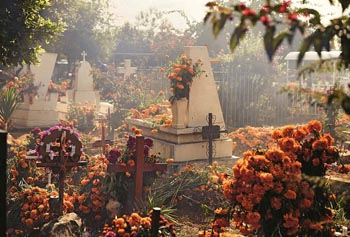
A sea of flowers on graves in Catholic countries
Many pious Catholics would keep their windows open throughout the day on All Souls Day so that the Souls in Purgatory could hear their prayers and be comforted by them.
The Austrians believed that on All Souls Day, the holy souls would wander through the forests invisible to mortal man. Austrian mothers and fathers instructed their children to recite prayers for the dead out loud when they walked in the fields and to church to give solace to the holy souls.
Visiting the graves
In some countries, the Requiem Mass was followed by a procession to the cemetery where the Vespers for the Dead was solemnly chanted. Catholics everywhere would go to the cemetery on this day to respectfully pray for the dead and adorn the graves.
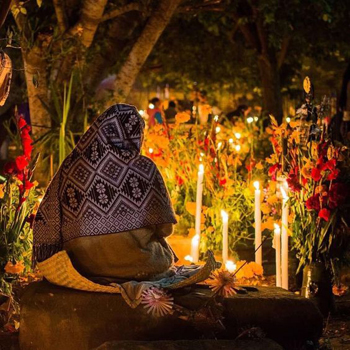
A mexican lady prays for the Poor Souls; below, a French family on their way to the cemetery
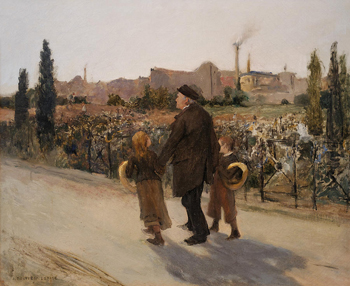
Many Catholics made great efforts to aid the Holy Souls. The Puerto Ricans often walked miles to visit the cemetery, the women dressed in their finest attire and carrying flowers and vases filled with water. Each grave received a blessing from the village priest, who recited the Prayers of the Dead while the people followed him in procession. Often, this procession would last until midnight, for the priest would not neglect a single grave.
In Mexico Catholics rose before dawn to go the cemeteries. They carried flowers and candles to adorn the graves along with skull-shaped, brightly-colored breads, cakes, candied pumpkin and sweets for a picnic by the family grave. Many Mexican families kept an all night vigil at the candlelit graves of their loved ones, praying, feasting, singing and retelling stories of their deceased family members.
Sicilians would lay out a banquet at the family tomb; at its center was a beautiful chrysanthemum bouquet. In some regions of Portugal and Lithuania, it was also traditional to have a picnic feast at the cemetery.
Almsgiving & charity
When the Catholics of the central European countries paid their visits to cemeteries on All Souls Day, there were always many poor people and beggars who flocked there to receive alms in return for prayers for the Holy Souls of the departed family members of their benefactors.
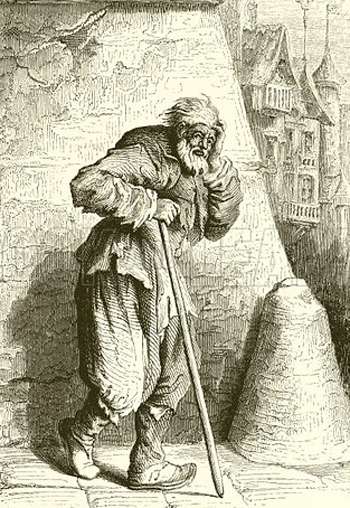
A beggar in Italy
The beggars not only prayed for the dead but also recited poetry, told tales, and sang songs about the saints to anyone who would stop to listen. Happy the days when even the poorest members of society gave glory to God!
In Hungary, orphan children were invited into every house to receive meals and gifts of clothing and toys.
In Russia the peasants placed wheat and honey on the graves of their relatives and offered these to any passer-by saying, "May God forgive your sins."
Soul food
Throughout time man has seen a symbolic connection between the dead and buried seeds. The winter seed sowed in September or October resembled the dead in their graves. For this reason, seeds, grain and bread were prominent foods for All-Hallowtide. Honoring the dead was also deemed a way to ensure a good harvest, especially by the Portuguese who considered the dead as "the guardians of the buried seed."
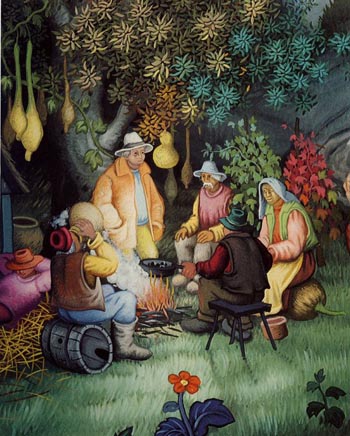
A simple feast of chestnuts in Portugal; below, marzipan, penllets & rosted chestnuts in Catalunya
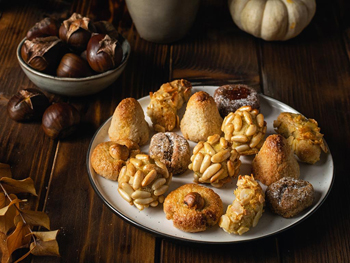
The fava bean was traditionally used in dishes from countries near the Mediterranean because of its ancient Roman and Greek association with the dead. The monks of Cluny understood how to change the pagan superstitions into a symbolic way to honor the dead. They boiled large pots of fava beans and offered them to the poor for the souls of the dead. This custom spread to the cities and towns where large pots of fava beans were left at street corners for all, especially the poor.
Each region of Italy had a distinct Italian dish eaten on this day. Some regions served dishes of Farro, or hulled wheat, because of its connection to new life. But the favorite traditional foods were the sweets.
Fava dei Morti (beans of the dead) were bean-shaped cakes made of ground almonds, sugar, butter, eggs and flour. These delectable cookies could be white, pink or chocolate, the marvelous colors adding charm of the feast. Ossi da morto (bones of the dead) were cookies made of almond and egg whites. Pupi di cana were sweets shaped in the form of human fingers. Armuzzi was a bread of the dead shaped like two crossed hands. Another was Pan dei morti, versions of which were also baked in Mexico, Portugal and other Latin countries.
Piedmont and Tuscany had chestnut festivals at this time of the year. In Italy, Spain and Portugal chestnuts were long considered ford for the dead. Hence, in many regions it was traditional to eat chestnut dishes on All Souls Day. Indeed, this was often the day that Italians waited for all year to eat their first roasted chestnuts of the autumn.
The Galicians and the Portuguese had an elaborate feast known as magusto, which always featured the new wine from the vineyards and chestnuts roasted over an open fire. Families gathered in houses or whole villages for an outdoor picnic on this joyful feast. In Galicia, if the meal were in a home, stews and hot pies accompanied the chestnuts, but if the meal were outdoors, a large main dish of rice was cooked. Even the bell ringers who had the responsibility of tolling the bells in honor of the dead all day had their own magusto in the belfry.
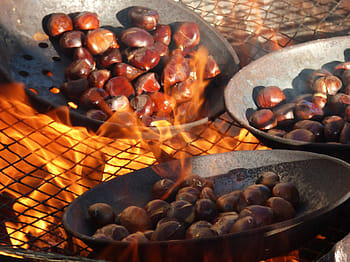
Chestnuts over an open fire; below, spice soul cakes with currant crosses

The Swiss enjoyed "Dry Bones Cookies." In the town of Provins near Paris, it was traditional to bake little tartlets known as Niflettes ("Cry No More").
Catholics of central Europe baked their All Souls Day cakes and breads using the same sweet dough as the "All Saints Bread." These cakes, baked in honor of the Holy Souls, were known as "All Souls Bread" and were given to children and to the poor. The Czechoslovakians drank cold milk along with their cakes "to cool the souls in Purgatory".
In the British Isles, these cakes were called "Soul Cakes" (known by the Scots as Dirge Cakes), seasoned with allspice, nutmeg, cinnamon, ginger or other spices and often filled with raisins or currants and marked with a cross. It was traditional to give a soul cake to every guest who came by the house on this day.
'Soul nights'
In Central Europe, the eight days after All Souls were known as "Soul nights" (Seelennachte). These were days of extra prayers, penances, good works and Masses said for the Holy Souls. The Church granted a plenary indulgence to be applied to the Poor Souls in Purgatory to those who visit a cemetery on any day within this octave.
Many people attended Mass every morning of the octave and prayed the Rosary every evening in front of a blessed candle. After every meal, a liberal portion of food was distributed to the poor. Dances and other such public entertainments were avoided during this time to respect the plight of the Holy Souls.
Would be very good if we could see these customs restored amongst today's Catholic men and women – lay and religious alike. We ought to show our devotion to the Church Suffering in Purgatory not only by our prayers, but also in our exterior actions in these sacred days of Hallowtide.
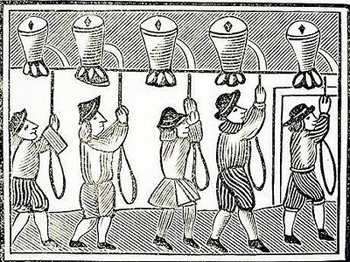
Bell-ringers chosen to toll the bells
on the hour throughout All Souls Day

Posted October 27, 2021
______________________
______________________








